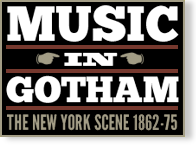Mason and Hamlin Organ Company Musical Recreation
Event Information
Venue(s):
Mason and Hamlin Warerooms
Performance Forces:
Instrumental
Record Information
Status:
Published
Last Updated:
14 April 2025
Performance Date(s) and Time(s)
18 Dec 1873, AfternoonProgram Details
Performers and/or Works Performed
Citations
“Musical Recreations.
The last of their series of musical recreations for the year 1873 was given by the mason & Hamlin Organ Company at their commodious hall on Union Square on Thursday afternoon, and was very fairly and fashionably attended. A pleasing programme was interpreted by [lists performers] and a vocal quartet recruited from the ranks of the Caroline Richings-Bernard ‘Olde Folks’ Musical Union.’
These invitation matinées have proved exceedingly attractive to amateurs, and the good taste displayed in the programmes has been justly commended. It will gratify many hundreds who have availed themselves of the invitations of the celebrated organ manufacturers to know that a new series of concerts upon the same popular plan will be begun on the 8th of January.
Of the ten selections comprising the programme Thursday afternoon, the more conspicuous, from effective treatment at the hands of the artists, were the reminiscences of ‘Trovatore,’ for harp and organ; Gounod’s ‘Ave Maria,’ by male quartet and four instruments; the ‘Inflammatus,’ from Rossini’s ‘Stabat Mater,’ the ‘Faust Fantasia,’ for organ and piano, and the ‘Song of the Christian’ (Casella), for violin, organ and piano.
Mr. Tomlin is a most capable performer on the reed organ. The effects which he produces through his masterly control of the stops are exceedingly beautiful. Indeed, the wonderfully developed instruments of Messrs. Mason & Hamlin, under the artistic manipulation of Mr. Tomlins, imitate a small orchestra. Now that expert performers are learning to appreciate the advantages which are afforded them for the display of a skill, it is evident that they must soon occupy an important place in the concert room. It is a gratifying evidence of the perfection attained by this famous American firm, in the manufacture of parlor and concert organs, that their instruments obtained the highest prizes at the Paris and Vienna exhibitions, and are now widely sought for in England, Germany and other parts of Europe. To meet the foreign demand for their instruments, Messrs. Mason & Hamlin have established agencies in London, Vienna and many lesser cities abroad.”

